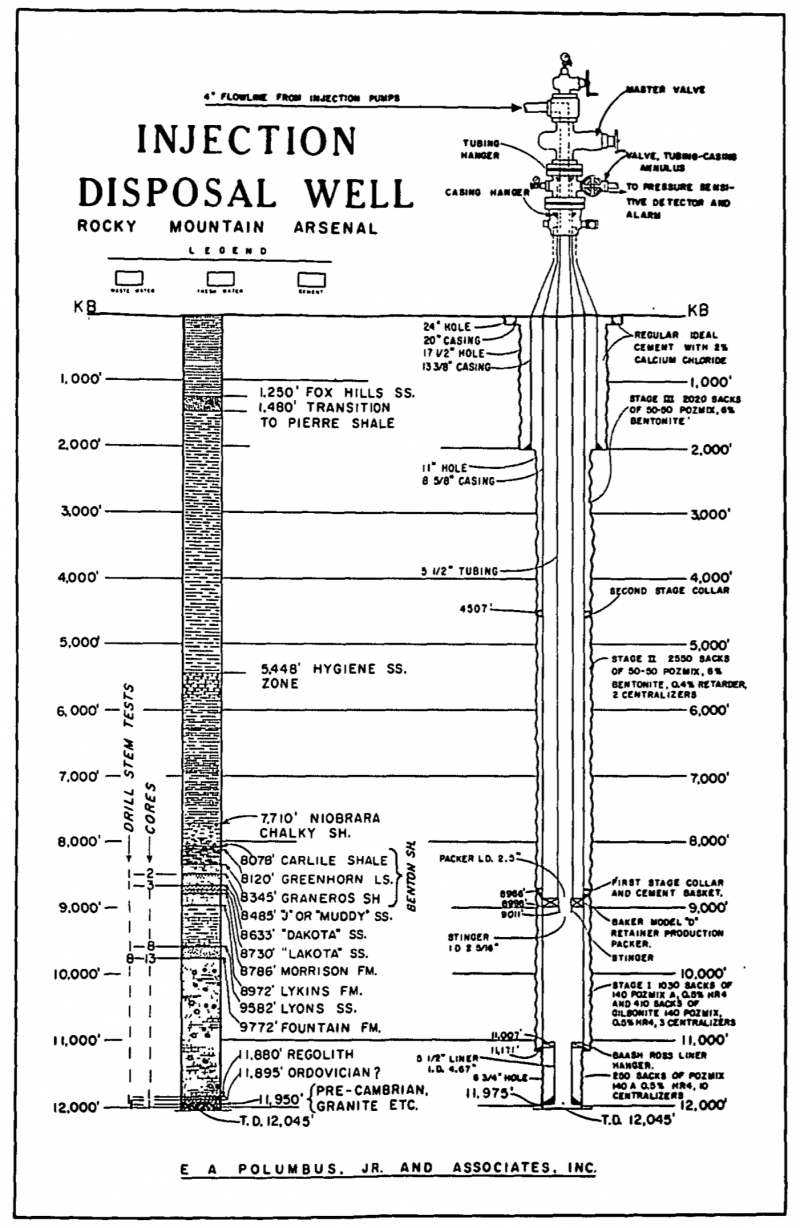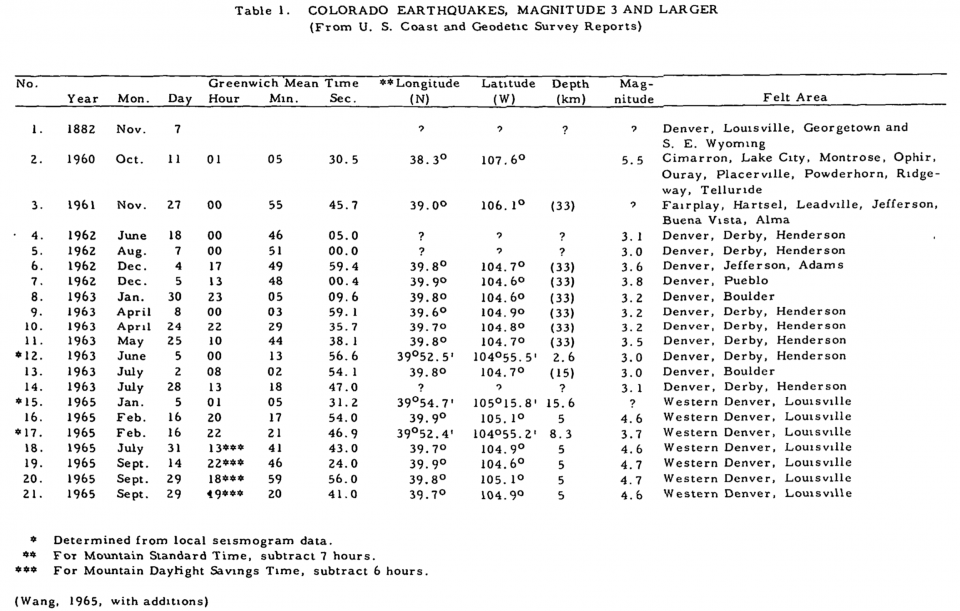From World War II through the 1970s, the U.S. Army Chemical Corps and a handful of private companies produced a range of chemical weapons at the Rocky Mountain Arsenal (RMA). Located less than fifteen miles to the northeast of Denver, Colorado, the RMA was one of the largest chemical weapons manufacturing sites in U.S. history. In the early 1980s the U.S. government declared the RMA a contaminated landscape (informally called a Superfund site) within the purview of the Comprehensive Environmental Response, Compensation and Liability Act. Due to the unanticipated return of various species following the closure of the RMA, the U.S. Fish and Wildlife Service took interest in the land. President George H.W. Bush eventually signed the Rocky Mountain Arsenal National Wildlife Refuge (RMANWF) Act, which pledged to assist in the return of iconic animals such as bison and bald eagles. While this is a well-known, if unusual, conservation story, the RMA is also an important site in the seismic history of the United States.

In 2007, Bison were introduced into the Rocky Mountain Arsenal National Wildlife Refuge.
In 2007, Bison were introduced into the Rocky Mountain Arsenal National Wildlife Refuge.
Photograph by Hans Watson.
Accessed via Flickr on 17 September 2019. Click here to view source.
 This work is licensed under a Creative Commons Attribution-NonCommercial-ShareAlike 2.0 Generic License.
This work is licensed under a Creative Commons Attribution-NonCommercial-ShareAlike 2.0 Generic License.
Since the emergence of the field of environmental history, environmental historians have utilized concepts from the physical sciences. One that has caught the attention of many historians is the Anthropocene, which is based on Paul Crutzen and Eugene Stoermer’s hypothesis from 2000. According to the atmospheric chemist and the diatom scientist, the planet has entered a new geological age due to humanity’s unprecedented modification of the atmosphere, biosphere, and hydrosphere. While this intellectual discourse has become rather robust in recent years, scholars have largely neglected to analyze how people have experienced, let alone resisted, the materialization of the Anthropocene at the local level. Such cases are important because they highlight the way people throughout the world have actually encountered the so-called new geological age.

A 1960 photograph of an unnamed guard at the south entrance of the Rocky Mountain Arsenal. Signs encourage visitors to do their part to prevent wildfires.
A 1960 photograph of an unnamed guard at the south entrance of the Rocky Mountain Arsenal. Signs encourage visitors to do their part to prevent wildfires.
Unknown photographer, c. 1960.
Courtesy of Library of Congress Prints and Photographs Division.
Accessed via Wikimedia on 17 September 2019. Click here to view source.
 This work is licensed under a Creative Commons Public Domain Mark 1.0 License.
This work is licensed under a Creative Commons Public Domain Mark 1.0 License.
The rise and fall of artificial earthquakes at the RMA serves as a useful example. In 1961, the U.S. Army drilled a two-mile-deep disposal well at the RMA. Officials believed the injection of millions of gallons of chemical byproducts into the ground served as a safe alternative to the prevailing evaporation method. However, the action drastically altered the subterranean environment. Within less than a year the Denver Metropolitan Area, a region not known for earthquakes, became one of the most seismically active regions in the nation. Between 1962 and 1967, the U.S. Geological Survey (USGS) recorded over 1,500 earthquakes along the Derby Fault, including a number of 5.0 magnitude earthquakes that caused damage to the DMA. Though residents escaped injuries, the earthquakes took a financial toll. According to the Colorado Geological Survey (CGS), a lone 4.8 magnitude earthquake, on 9 August 1967 cost over 1 million U.S. dollars in property damages.

In 1966, David Evans published a report linking the earthquakes with the Rocky Mountain Arsenal. To many people in the Denver Metropolitan Area this evidence solidified the correlation.
In 1966, David Evans published a report linking the earthquakes with the Rocky Mountain Arsenal. To many people in the Denver Metropolitan Area this evidence solidified the correlation.
Originally published in Evans, “The Denver Area Earthquakes and the Rocky Mountain Arsenal Disposal Well,” 27.
Used by permission.
The copyright holder reserves, or holds for their own use, all the rights provided by copyright law, such as distribution, performance, and creation of derivative works.
Three individuals were responsible for initially linking the earthquakes to the RMA disposal well: Yung-Liang Wang, Joseph V. Downey, and David Evans. Due to the uncharacteristic outbreak the USGS established additional seismograph stations throughout the DMA. While in graduate school at the Colorado School of Mines, Wang used the new data to locate the specific location of the earthquakes. Meanwhile, Downey, as the director of Denver’s Regis College Seismological Observatory, was one of the first individuals to propose a correlation between the RMA disposal well and the earthquakes. Evans, who was a local geologist, expanded on the insights of Wang and Downey and publicly declared that the RMA’s disposal well triggered the earthquakes in a 1966 article in The Mountain Geologist.

The 12,045-foot (3,671-meter) RMA injection disposal well was considered revolutionary for the time. In 1961, it was one of the deepest wells in the United States.
The 12,045-foot (3,671-meter) RMA injection disposal well was considered revolutionary for the time. In 1961, it was one of the deepest wells in the United States.
Originally published in Evans, “The Denver Area Earthquakes and the Rocky Mountain Arsenal Disposal Well,” 25.
Used by permission.
The copyright holder reserves, or holds for their own use, all the rights provided by copyright law, such as distribution, performance, and creation of derivative works.
Though Evans’s hypothesis was met with skepticism from the scientific community, many DMA residents took an interest in his theory due to their lived experience of the earthquakes. In addition to the local media, newspapers such as the Los Angeles Times covered their experiences and broadcast their concerns. This publicity led U.S. Representative Roy McVicker (Democrat of Colorado) to hold a public hearing on the source of the earthquakes and subsequently called for a federal investigation. To the delight of the DMA community, the U.S. Army ceased injecting chemical byproducts into the lithosphere in February 1966. One month later the USGS released a report that confirmed the reasons for the outbreak of artificial earthquakes at the RMA.
As artificial earthquakes are on the rise throughout the United States due to fracking and wastewater injection, Americans would do well to be mindful of this story in the early twenty-first century. The RMA earthquakes reveal one of the first instances in which the United States experienced induced seismicity. Yet it did not last long because the residents of the DMA demarcated the triggering of artificial earthquakes as a line that human beings should not transgress. While it was one thing for the federal government to produce chemical weapons in Denver’s backyard, it was unacceptable to allow the army to act as a geological force, on a par with the most powerful natural hazards on earth. This demonstrates that Americans do in fact have the ability to resist the U.S. government in the midst of the Anthropocene.

This image highlights the major earthquakes within the Denver Metropolitan Area through 1965.
This image highlights the major earthquakes within the Denver Metropolitan Area through 1965.
Originally published in Evans, “The Denver Area Earthquakes and the Rocky Mountain Arsenal Disposal Well,” 29.
Used by permission.
The copyright holder reserves, or holds for their own use, all the rights provided by copyright law, such as distribution, performance, and creation of derivative works.
How to cite
Whitney, Justin. “Resistance in the Midst of the Anthropocene: The Rise and Fall of Artificial Earthquakes at the Rocky Mountain Arsenal, 1962–1966.” Environment & Society Portal, Arcadia (Autumn 2019), no. 35. Rachel Carson Center for Environment and Society. doi.org/10.5282/rcc/8880.
ISSN 2199-3408
Environment & Society Portal, Arcadia
 This work is licensed under a Creative Commons Attribution 4.0 International License.
This work is licensed under a Creative Commons Attribution 4.0 International License.
2019 Justin Whitney
This refers only to the text and does not include any image rights.
Please click on the images to view their individual rights status.
- Cronon, William. “Introduction: In Search of Nature.” In Uncommon Ground: Rethinking the Human Place in Nature, edited by William Cronon, 57–66. New York: W.W. Norton & Company, Inc., 1996.
- Crutzen, J. Paul, and Eugene F. Stoermer. “The Anthropocene.” IGBP Newsletter 41 (May 2000): 17–18.
- Evans, David M. “The Denver Area Earthquakes and the Rocky Mountain Arsenal Disposal Well.” The Mountain Geologist 3, no. 1 (1966): 23–36.
- Havlick, David G., Marion Hourdequin, and Matthew John. “Examining Restoration Goals at a Former Military Site: Rocky Mountain Arsenal, Colorado.” Nature and Culture 9, no. 3 (Winter 2014): 288–315.
- Healy, John H., et al. Geophysical and Geological Investigations Relating to Earthquakes in the Denver Area, Colorado. Reston: U.S. Geological Survey, 1966.
- McNeill, John R., and Peter Engelke. The Great Acceleration: An Environmental History of the Anthropocene since 1945. Cambridge: Belknap Press, 2016.
- Zalasiewicz, Jan, et al. “When Did the Anthropocene Begin? A Mid-Twentieth Century Boundary Level is Stratigraphically Optimal.” Quaternary International 383 (October 2015): 204–207.








